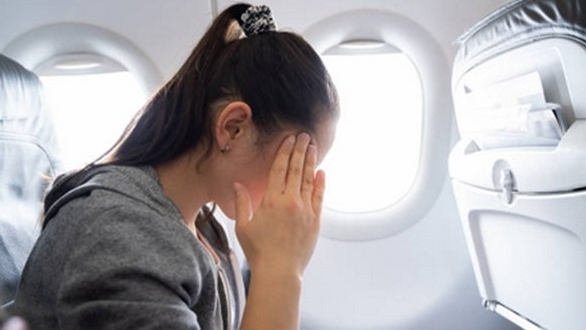La paura di volare, nota anche come aerofobia, è un disturbo che colpisce molte persone. Si manifesta con un’intensa ansia prima e durante il volo, spesso accompagnata da tachicardia, sudorazione e vertigini. Ne abbiamo parlato con Antonio Cerasa, direttore dell’Istituto bioimmagini e sistemi biologici complessi del Cnr, che ha anche spiegato come intervenire per eliminarla
Molte volte ci sarà capitato di salire su un aereo e avere sul sedile a fianco a noi una persona che comincia a stare male ai primi segni di turbolenza dell’aereo. Probabilmente soffre di aerofobia, che non è soltanto uno stato di malessere provocato dai movimenti imprevisti della cabina dell’aereo, ma un disagio emotivo, legato all’ansia, che si manifesta spesso ancora prima di essere in volo. “È una malattia invalidante che impedisce a molte persone – per lo più adulte – di poter prendere aerei, limitandone gli spostamenti e la possibilità di visitare luoghi lontani. In alcuni soggetti è così limitante che si manifesta già solo al pensiero di dover prenotare un volo, e in molti, non potendo rinunciare a questo mezzo di trasporto, ricorrono a psicofarmaci pur di limitare gli effetti dell’ansia”, spiega Antonio Cerasa, direttore dell’Istituto bioimmagini e sistemi biologici complessi (Ibsbc) del Cnr
Sebbene, quindi, siano molte le persone che sperimentano un certo disagio nei viaggi aerei, per alcune l’ansia può diventare invalidante, limitando la loro mobilità e la qualità della vita. Vediamo allora quali sono i fattori psicologici o esperienziali che contribuiscono a generare questa paura. “Le radici dell’aerofobia sono complesse e possono variare da persona a persona, ma hanno una base comune nei sistemi di allarme legati ad alti livelli di ansia. Tra le principali cause psicologiche, troviamo la paura di perdita del controllo, la claustrofobia e la presenza di esperienze traumatiche. La prima è la più comune perché nasce dal pensiero disfunzionale che affidarsi completamente ai piloti e al funzionamento dell’aereo può generare un forte senso di vulnerabilità; la seconda, invece, è legata a forti stati di ansia generalizzata, scatenata da qualsiasi posto chiuso – per esempio gli ascensori -; la terza è più rara e riguarda, per esempio, l’aver vissuto forti esperienze negative su voli aerei”, chiarisce l’esperto. “Quella che noi chiamiamo ansia, è una serie di pensieri che allertano l’asse ipotalamo-ipofisi-surrene a prepararsi allo stress, quando in realtà questo è presente solo nella nostra mente, ma non è realmente tangibile. L’ansia si trasforma in una malattia psicopatologica quando diventa cronica e provoca ricadute a livello organico, costringendo la persona a ridurre le proprie attività di vita quotidiana e a ricorrere a farmaci per la gestione quotidiana delle emozioni”.

È comunque possibile risolvere queste manifestazioni d’ansia legate alla paura di volare attraverso percorsi psicoterapeutici che aiutano la persona a comprendere le cause profonde della fobia, a modificare i pensieri e le emozioni disfunzionali. “La prima linea di trattamento per l’aerofobia è la psicoterapia cognitivo comportamentale, che permette, grazie a tecniche come la desensibilizzazione sistemica o la mindfulness, di associare uno stimolo fobico (aereo) con stati di rilassamento del corpo. Una sorta di controcondizionamento, che nel tempo permette alla mente di rielaborare i pensieri disfunzionali legati a uno stimolo che prima era fobico ma poi diventa neutrale. L’efficacia della psicoterapia cognitivo comportamentale è ormai comprovata da oltre 20 anni di studi evidence-based”, conclude il direttore del Cnr-Ibsbc.
La paura di volare è quindi un problema comune, ma affrontabile: con un supporto psicologico adeguato e tecniche mirate è possibile vincere questa fobia e tornare a viaggiare serenamente e senza stress.
Fear of flying, also known as aerophobia, is a disorder that affects many people. It manifests itself with intense anxiety before and during the flight, often accompanied by tachycardia, sweating and dizziness. We talked about it with Antonio Cerasa, director of the Institute of Bioimages and Complex Biological Systems of the CNR, who also explained how to intervene to eliminate it
Many times, we have happened to get on a plane and have a person on the seat next to us who begins to feel sick at the first signs of turbulence in the plane. He probably suffers from aerophobia, which is not only a state of malaise caused by the unexpected movements of the plane cabin, but an emotional discomfort, linked to anxiety, which often manifests itself even before being in flight. “It is a disabling disease that prevents many people – mostly adults – from being able to take planes, limiting their movements and the possibility of visiting distant places. In some subjects it is so limiting that it manifests itself even at the thought of having to book a flight, and in many, unable to give up this means of transport, resort to psychotropic drugs in order to limit the effects of anxiety”, explains Antonio Cerasa, director of the Institute of Bioimages and Complex Biological Systems (Ibsbc) of the CNR
Although, therefore, there are many people who experience some discomfort in air travel, for some anxiety can become disabling, limiting their mobility and quality of life. So let’s see what are the psychological or experiential factors that contribute to generating this fear. “The roots of aerophobia are complex and can vary from person to person, but they have a common basis in alarm systems linked to high levels of anxiety. Among the main psychological causes, we find the fear of loss of control, claustrophobia and the presence of traumatic experiences. The first is the most common because it arises from the dysfunctional thought that relying completely on pilots and the operation of the plane can generate a strong sense of vulnerability; the second, on the other hand, is linked to strong states of generalized anxiety, triggered by any closed place – for example elevators -; the third is rarer and concerns, for example, having had strong negative experiences on air flights,” the expert clarifies. “What we call anxiety is a series of thoughts that alert the hypothalamic-pituitary-adrenal axis to prepare for stress, when in reality this is only present in our mind, but it is not really tangible. Anxiety turns into a psychopathological illness when it becomes chronic and causes relapses on an organic level, forcing the person to reduce their daily life activities and resort to drugs for the daily management of emotions”.
However, it is possible to resolve these manifestations of anxiety related to the fear of flying through psychotherapeutic paths that help the person understand the root causes of the phobia, to modify dysfunctional thoughts and emotions. “The first line of treatment for aerophobia is cognitive behavioral psychotherapy, which allows, thanks to techniques such as systemic desensitization or mindfulness, to associate a phobic (airborne) stimulus with states of relaxation of the body. A sort of counterconditioning, which over time allows the mind to reprocess dysfunctional thoughts related to a stimulus that was previously phobic but then becomes neutral. The effectiveness of cognitive behavioral psychotherapy is now proven by over 20 years of evidence-based studies,” concludes the director of the Cnr-Ibsbc.
The fear of flying is therefore a common problem, but one that can be addressed: with adequate psychological support and targeted techniques, it is possible to overcome this phobia and return to travelling serenely and without stress.







